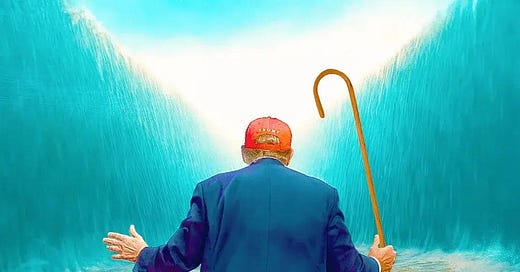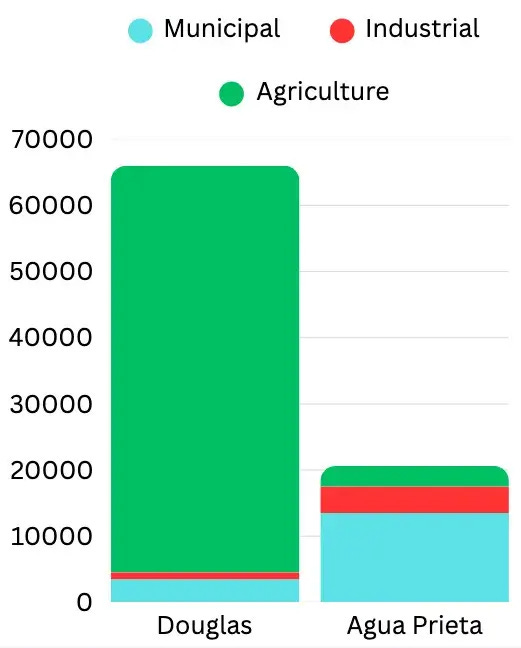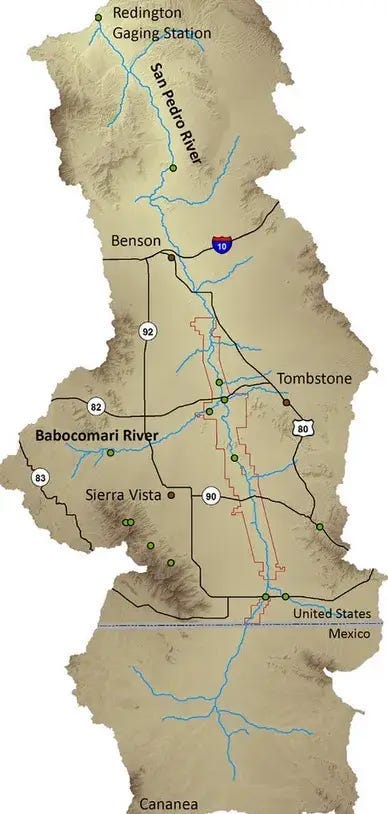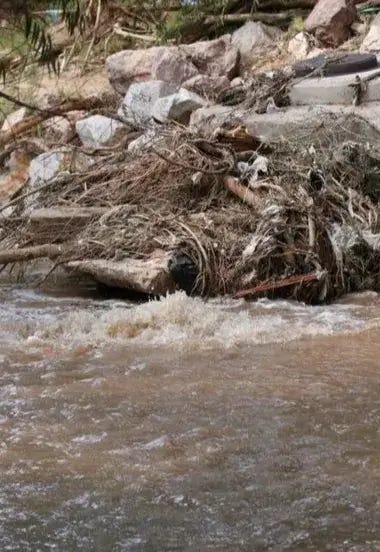Trump declares Water War
Water is the new tariff … Arizona is the bad apple … And Griffin is dealt a full House.
“But what about Mexico?”
That question — which you’ll understand better in a moment — came up a lot from anti-AMA folks during the Douglas AMA election.
The Douglas Basin doesn’t stop at the Mexico border — it just changes names to the Agua Prieta Basin. So why should we regulate pumping on one side of the basin when we’ve got no say over the other?
Fair question, with some complexities.
But not nearly as complex as the emergent water standoff between the U.S. and Mexico, where millions of people, dollars, and acrefeet of water are in play.
We’ll zoom out soon for the bi-national view, but first we’ll take a tour of the Arizona-Mexico border, starting in Douglas and heading west from there.
The Water Agenda has a border running through it too, and we always welcome more residents on the “paid supporter” side. Join us. The water’s great over here.
In a previous edition of the Water Agenda, I posited:
“It wouldn’t make sense to limit pumping in one part of the underground bathtub while the same supply of water can be pumped to death elsewhere.”
But the Douglas Basin is, literally, an edge case. We can’t regulate past the state line. So does that make conservation pointless?
Not at all. In fact, Agua Prieta, Sonora, would struggle to cut back water use even if it wanted to.
The Douglas Basin uses about 62,000 acre-feet of water each year, serving around 23,852 people. Across the border, Agua Prieta is home to 92,000 people.
So who’s thirstier?
That would be Douglas, thanks to its 19,700 irrigated acres of farmland versus Agua Prieta’s 1,000 acres. So, only Arizona has a hefty ag water demand that could be reduced to stabilize our shared water supplies.
Even my water-use chart up there isn’t quite fair, because I’m applying Arizona water consumption rates to Agua Prieta’s population and farming. Most of Agua Prieta’s irrigation uses treated wastewater deliveries from Douglas, not groundwater. And on average, Mexican residents use 71 gallons of water per day — for Arizonans, it’s 146 gallons.
And groundwater in the Douglas Basin “underflows” southward into Mexico. So Arizona’s overpumping mostly threatens Mexico’s supply, not the other way around.
Speaking of underflow, most of that underground flow happens along a channel called the White Water Draw — but it was called the “White River Draw” back when overpumping hadn’t yet diminished its surface waters.
We also used to have a copper smelter along the Draw, right at the border. The top source of arsenic in the world? Copper smelting. After it got shut down in 1987 for making people sick, they demolished and buried the monstrosity on site. Later, Douglas’ nearby municipal well was shut down too — prohibited levels of arsenic found in its water.
You have to wonder — is arsenic-laced groundwater now drifting south into Mexico along the Draw?
Maybe someone should check on that.
Moving west along the border…
From Douglas, our first stop is the twin cities of Naco, Arizona and Naco, Sonora — where septic seepage has been causing bureaucratic headaches and actual headaches for decades. Sonora’s Naco has an outdated and undersized sewage system, and to prevent backups into homes, sewage is released onto public land.
Previously, 60 gallons of sewage flowed freely into Arizona every minute, sometimes spiking to 6,000 gallons per minute. Remediation projects and the construction of the border wall reduced flows across the border, but the problem — including terrible odors and threats to groundwater quality — persists. In 2023, the EPA finally started working toward a long-term fix.
Next up: the beloved San Pedro River, with headwaters in Cananea, Sonora. This is a good moment to introduce you to the 1944 US-Mexico Water Treaty, the main character in today’s Trump-vs-Mexico story. Under this treaty, the U.S. and Mexico began jointly studying and conserving the San Pedro — one of the last undammed rivers in the Southwest.
Then we meet another river: the Santa Cruz. And another twin city pair, Nogales and Nogales, which are dealing with another sewage saga. In Mexico’s Nogales, poorly treated effluent distributed to the river was choking aquatic life and killing off trees along the riverbanks. After sustained community pressure, treatment systems were upgraded and the river rebounded.
But “Ambos Nogales” — the twin cities’ joint name — has another plumbing problem.
Mexico’s Nogales sends its sewage to a treatment plant in Rio Rico, Arizona, via a submerged pipeline built in the ‘70s. Time hasn’t been kind to the pipe — leaks let sewage escape in some spots and groundwater flood in elsewhere, overloading the treatment plant. After decades of complaints from locals, the US-Mexico International Boundary and Water Commission recently came to the rescue, finishing a series of pipeline repairs last year and securing federal funds to take over its ownership and management.
And last, let’s take a quick detour to Arizona’s California Gulch where we find the Sonoran chub — a small, unassuming fish that never asked to be part of a geopolitical drama — experiencing a housing crisis as new pavement along the border wall cuts off streamflow and turns its habitat into glorified puddles. The U.S. Fish and Wildlife Service might put off responding to the chub’s plight until 2027, AZPM’s Katya Mendoza reports.
Trump’s Water War
Now, back to that 1944 Water Treaty, when the U.S. agreed to deliver 1.5 million acrefeet of Colorado River water to Mexico every year, and Mexico agreed to 350,000 acrefeet of Rio Grande water for the U.S. annually.
This arrangement was working fine until the 1990s, when Mexico experienced severe drought and didn’t deliver its scheduled allotments of water. They eventually paid their water debts, but another drought put them back into debt in 2021.
Meanwhile, Mexico has been paying for emergency water deliveries from the U.S. with increasing frequency since 1972.
Last week marked the first time the U.S. has ever denied one of those deliveries.
To understand why Mexico desperately needs the water, we have to go to Tijuana.
And to understand why Trump is denying them that water, we have to go to Texas.
Paid subscribers can read our full story by clicking here — it’s a wild ride.
To learn more about the U.S. and Mexico’s joint efforts in studying our transboundary aquifers, you can attend UofA’s Water Webinar on the topic today (Friday) at 12pm by registering here.
And the US-Mexico International Boundary Water Commission is holding a Southeast Arizona Citizens Forum Public Meeting online and in Tucson on April 15.
Exporting water, importing criticism: In a 3,000-word prepared statement on water management, Colorado Attorney General Phil Weiser points to Arizona’s Saudi alfalfa problem as “perhaps the most glaring example” of water mismanagement hurting local communities. He also writes about the problem of “buy and dry schemes,” where private entities buy up rural farmers’ water rights and sell them to urban areas — something Arizona’s Legislature has refused to address despite efforts from some rural officials and lawmakers. Criticism of Arizona’s water management will likely continue as Arizona officials continue to demand the Upper Basin states reduce their water use in upcoming Colorado River settlements.
Speaking of “buy and dry”: The rapidly growing Town of Queen Creek wants to raise its water rates by 15%, mostly to restructure its $85 million loan to buy groundwater from a private investor who bought out farmland in the rural Harquahala Basin. Only one resident commented at the public hearing, asking council members if they could instead, please, lower the rates.
Buy us out before Big Water does.
Become a Paid Supporter.
Water from the sun: The Hopi Tribe just received $4.17 million from the U.S. Department of Energy to construct a solar-powered microgrid that will power two remote wells and supply water to the villages of Upper and Lower Moenkopi. The system will significantly reduce fuel costs for the diesel engines that currently power the wells.
Legendary Leona: Last weekend, Leona Carlyle-Kakar was inducted into the Arizona Farm and Ranch Museum Hall of Fame. She passed away last April at the age of 88, and is remembered for being a key figure in the first Tribal water rights settlement in the nation, and the first woman to serve as chairperson for the Ak-Chin Indian Community, per ABC15’s Nick Celetti.
Mineral water: Local environmental champions are pressing back against the development of the Copper Creek mining project in the San Pedro River Valley, citing impacts on groundwater and the valley’s long history as a uniquely protected region, John Leos reports for the Republic. And in Sahuarita, local group Save the Scenic Santa Ritas has been protesting the Copper World mining project, citing concerns about water and air pollution, per KGUN9’s Joel Foster.
A Superior habitat: Until this week, Arizona’s native desert pupfish could no longer be found in the wild. But the Boyce Thompson Arboretum conserved a population of the species and released some into Superior’s Lake Ayer, where they’ll be protected by environmental regulations.
The Senate Natural Resources Committee advanced six of Rep. Gail Griffin’s bills this week. The only one that stands a chance against Gov. Katie Hobbs’ veto pen is HB2103, which would give the Department of Water Resources $1 million for potential litigation over interstate Colorado River disputes. Hobbs had previously requested $3 million for the looming legal fights.
Also this week, Griffin put the Farm Bureau’s unpopular groundwater management bill, SB1520, up for a vote. The hearing drew stakeholders from around the state, including many of my neighbors in Sulphur Springs Valley. Discussion and public comment on the bill lasted for 90 minutes. You can watch the hearing here.
If you’ve ever thought about commenting on bills at a legislative hearing, or sending impassioned letters to your elected officials, you might be interested in an upcoming workshop on “effective public comment.” The Center for Biological Diversity will host the event on Tuesday, April 1, online and in person.
And on Saturday, April 12, the Citizens Water Advocacy Group presents Chris Kuzdas of Environmental Defense Fund, who will give a presentation on “local community efforts seeking local control and self-determination over groundwater supplies across rural Arizona over the last several years” and “specific water bills,” along with discussion and Q&A. The event is in Prescott, but you can join via ZOOM. Find more information here.












